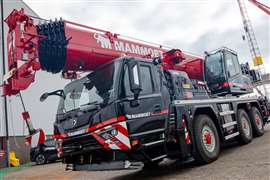Crane lighting is both strategic and crucial
04 December 2017
Tower cranes have been the obvious light tower for any project. The illumination of a project at night can be achieved by the placement of lights in strategic locations on the tower crane’s tower and upper structure, including the boom or jib, counterjib and turntable. But simply buying lights and mounting them wherever they fit is a bad practice that is all to often done. The variables in assuring that the lighting value you plan on achieving are extensive and should be considered in advance of the crane being erected on the project.

Step one
The first step to assuring you properly illuminate the areas intended with adequate light entails hiring an engineering or consulting firm that specializes in lighting. Simply relying on an electrical contractor or even worse, mounting lights wherever it “looks right,” may result in undesirable performance issues. These firms have the expertise and know how to calculate coverage, lumens and focus of lighting on the project to ensure the adequate coverage you expect to achieve. There are many factors that they will take into consideration:
- The height of the crane above the ground or elevated areas under construction, such as decks.
- The spectrum and width of the lighting below, and color tones and light intensity.
- The lumens (brightness) required or expected to carry out the related work at night.
The engineers can advise on the proper lights, quantity required and locations to best illuminate the anticipated area. In some cases, the lights may be mounted on the tower sections at a pre-determined elevation, or they may be mounted on the upper portion of the crane such as the jib or boom. And in some situations, both locations may offer the optimal results. (See Diagram 1).
Keep in mind that light projection may extend outside of the project to neighboring buildings or areas that may be undesirable or intrusive. Bright lights shining into a nearby residence will surely bring protests and cease demands if not addressed properly.
Step two
The second step is to determine where the lights will be mounted and how. Planning on the proper mounting techniques and using the proper mounting equipment is essential for the proper performance of the lights and for safety as well. All light fixtures should be securely mounted and not installed in a haphazard way. (See Photo 1.)
Improperly installed light fixtures can become dislodged, resulting in numerous safety hazards such as falling completely off and to the ground and creating an electrical hazard to anyone in the vicinity of the light fixtures. At this stage, working with the crane manufacturer or supplier is essential to come up with a plan on how and where to mount the lights exactly. Many considerations need to be taken into account, including:
- Location so as not to interfere with the crane drives, ropes and other possible apparatus.
- Ensure that the lights do not create a passage hazard, such as blocking walkways, steps, or access areas of the crane.
- Electrical connections, wiring, and controls are secured properly.
Determining these steps with the supplier or manufacturer is necessary prior to the crane arriving on site. There may be restrictions on the mounting locations, or even capacity reductions required for the load chart depending on the additional weight of the light fixtures that should be addressed up front.

Step three
Finally, and one of the most important steps, is to ensure the electrical wiring and connections are performed by a qualified electrician and in accordance with local and national regulations, such as the National Electric Code. Too many times the wiring is done poorly without any regard for the safe operation of the lighting and worse, the electrocution hazard to the operator or other personnel who may come in contact with the fixtures or wiring. Wire nuts and electrical tape are not proper ways to secure terminal connections, nor is wiring that is intended to be used inside of conduit or walls. Connections and wiring need to be properly fused and grounded to code.
Morrow has had a few technicians injured, and in one case severely burned, by improperly connected wiring into the electrical panel of the crane by unqualified personnel, where loose or poor connections were not evident until the connection was moved or disturbed creating a dead short and arc flash1.
The electrician basically hooked up residential wires to a 300A 480V main power terminal in the crane’s electrical control panel to power the lights with no proper fusing or connections. In no case should the electricians make any connections to the crane’s power supplies or electrical panels without specific advice from the manufacturer or supplier. A designated connection should be provided by the manufacturer or supplier, or detailed instructions should be provided on where a safe connection can be made.
After the last incident Morrow had involving an injury, we offered each customer a designated connection box that is separated from the crane’s electrical system. (See Photo 2.) This allows the electricians to connect to the 480V supply power, necessary for the lighting power for the lights, to the crane without having to open electrical enclosures or interfere with the crane’s electrical system. Keep in mind this is just the connection point. The electrician will still need to install the proper transformers and electrical protection along with wiring in a safe manner consistent with code. Wiring should be properly secured so as not to create a tripping or fall hazard. Finally, have a method and plan in place to replace bulbs as needed. Ensure the mounting of the lights allows access to the fixtures to enable relatively easy access in the event the bulb or cover needs to be changed.
Planning ahead cannot be stressed enough when it comes to illumination. Ensuring that the project will have the intended illumination and the safe working environment desired will make operations at night or with limited daylight safe and productive. And don’t forget key access and egress locations on the crane and project. Consult with experts to alleviate to confirm you get it right the first time.
STAY CONNECTED


Receive the information you need when you need it through our world-leading magazines, newsletters and daily briefings.
CONNECT WITH THE TEAM











